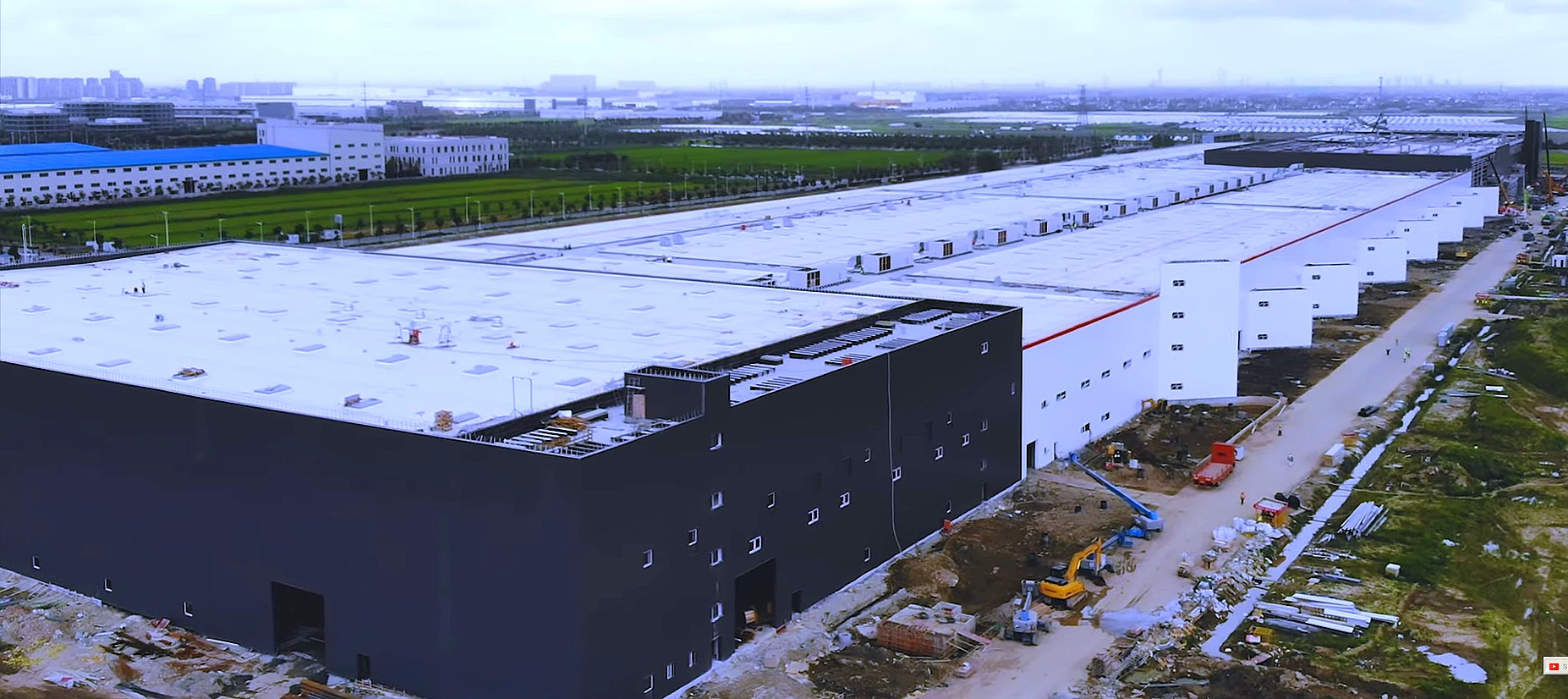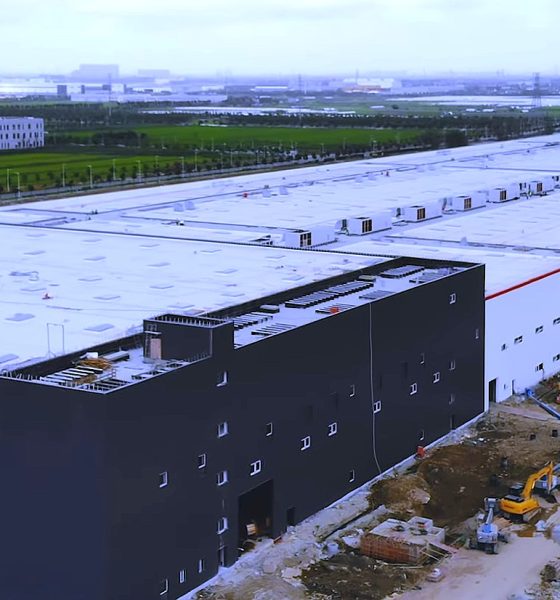

News
Tesla Gigafactory 3 shows remarkable progress as site gets graced by major gov’t official
Tesla’s Gigafactory 3 in China continues to evolve by the week, with recent drone footage of the complex providing a glimpse at the remarkable progress of the activities inside and outside the electric car production facility. Based on recent videos taken of the site, it appears that Gigafactory 3’s workers are sprinting towards the factory’s completion, as the team attempts to hit the ambitious goal of starting local Model 3 production later this year.
The recent footage of the Gigafactory 3 complex was shared on YouTube by Tesla enthusiast and drone operator Jason Yang, who has been following the progress of the site since January, when the site was but an empty field with a few pile drivers. Particularly impressive in the new footage was the completion of the facility’s roofing, which now appears to be completely paved. Most areas are even overlaid with white paint, giving Gigafactory 3’s general assembly building that clean, unmistakable Tesla look.
Also notable were the doors that are now being installed in the bays lining Gigafactory 3’s sides. Semi-trailers will be loading and unloading items from these massive doors, allowing Gigafactory 3 to take and conduct deliveries in an efficient manner. A number of the facility’s windows are also being finished, as more sections of the general assembly building’s exterior are completed.
Over the course of the recent flyover, it was evident that workers in the Gigafactory 3 complex are currently working on the areas surrounding the main electric car production facility. More operating platforms have also been installed around the main plant, and other projects, such as the substation southwest of the general assembly building, continue to make progress. Based on these activities, it was evident that Tesla and its Chinese construction partner are pushing hard to complete the facility on time, or perhaps even ahead of schedule.
These recent developments in the Gigafactory 3 complex come on the heels of a high-profile visit by Shanghai Party Secretary Li Qiang, who emphasized his full support for the construction of the upcoming Tesla Model 3 and Model Y production facility. Qiang’s visit is particularly notable, especially since party secretaries hold a prominent place in the Chinese government, exceeding that of officials like mayors. In a way, Qiang’s visit is the latest sign yet that the local government is fully backing the Silicon Valley-based electric car maker.
Earlier this month, reports from Chinese media pointed at Tesla starting the employment of its first batch of workers by the end of July. While this announcement seemed incredibly ambitious given that Gigafactory 3 is still under construction, footage taken of seemingly completed offices inside the Shanghai-based complex have revealed that some sections of the site are already hosting offices. Tesla has reportedly deployed 30 overseas employees to Gigafactory 3, who are currently working closely with a team of 140 Tesla China employees. By the end of this month, this number would likely see a lot of growth.
Watch the recent flyover of Gigafactory 3 in the video below.

News
Tesla starts showing how FSD will change lives in Europe
Local officials tested the system on narrow country roads and were impressed by FSD’s smooth, human-like driving, with some calling the service a game-changer for everyday life in areas that are far from urban centers.

Tesla has launched Europe’s first public shuttle service using Full Self-Driving (Supervised) in the rural Eifelkreis Bitburg-Prüm region of Germany, demonstrating how the technology can restore independence and mobility for people who struggle with limited transport options.
Local officials tested the system on narrow country roads and were impressed by FSD’s smooth, human-like driving, with some calling the service a game-changer for everyday life in areas that are far from urban centers.
Officials see real impact on rural residents
Arzfeld Mayor Johannes Kuhl and District Administrator Andreas Kruppert personally tested the Tesla shuttle service. This allowed them to see just how well FSD navigated winding lanes and rural roads confidently. Kruppert said, “Autonomous driving sounds like science fiction to many, but we simply see here that it works totally well in rural regions too.” Kuhl, for his part, also noted that FSD “feels like a very experienced driver.”
The pilot complements the area’s “Citizen Bus” program, which provides on-demand rides for elderly residents who can no longer drive themselves. Tesla Europe shared a video of a demonstration of the service, highlighting how FSD gives people their freedom back, even in places where public transport is not as prevalent.
What the Ministry for Economic Affairs and Transport says
Rhineland-Palatinate’s Minister Daniela Schmitt supported the project, praising the collaboration that made this “first of its kind in Europe” possible. As per the ministry, the rural rollout for the service shows FSD’s potential beyond major cities, and it delivers tangible benefits like grocery runs, doctor visits, and social connections for isolated residents.
“Reliable and flexible mobility is especially vital in rural areas. With the launch of a shuttle service using self-driving vehicles (FSD supervised) by Tesla in the Eifelkreis Bitburg-Prüm, an innovative pilot project is now getting underway that complements local community bus services. It is the first project of its kind in Europe.
“The result is a real gain for rural mobility: greater accessibility, more flexibility and tangible benefits for everyday life. A strong signal for innovation, cooperation and future-oriented mobility beyond urban centers,” the ministry wrote in a LinkedIn post.
News
Tesla China quietly posts Robotaxi-related job listing
Tesla China is currently seeking a Low Voltage Electrical Engineer to work on circuit board design for the company’s autonomous vehicles.

Tesla has posted a new job listing in Shanghai explicitly tied to its Robotaxi program, fueling speculation that the company is preparing to launch its dedicated autonomous ride-hailing service in China.
As noted in the listing, Tesla China is currently seeking a Low Voltage Electrical Engineer to work on circuit board design for the company’s autonomous vehicles.
Robotaxi-specific role
The listing, which was shared on social media platform X by industry watcher @tslaming, suggested that Tesla China is looking to fill the role urgently. The job listing itself specifically mentions that the person hired for the role will be working on the Low Voltage Hardware team, which would design the circuit boards that would serve as the nervous system of the Robotaxi.
Key tasks for the role, as indicated in the job listing, include collaboration with PCB layout, firmware, mechanical, program management, and validation teams, among other responsibilities. The role is based in Shanghai.
China Robotaxi launch
China represents a massive potential market for robotaxis, with its dense urban centers and supportive policies in select cities. Tesla has limited permission to roll out FSD in the country, though despite this, its vehicles have been hailed as among the best in the market when it comes to autonomous features. So far, at least, it appears that China supports Tesla’s FSD and Robotaxi rollout.
This was hinted at in November, when Tesla brought the Cybercab to the 8th China International Import Expo (CIIE) in Shanghai, marking the first time that the autonomous two-seater was brought to the Asia-Pacific region. The vehicle, despite not having a release date in China, received a significant amount of interest among the event’s attendees.
Elon Musk
Elon Musk and Tesla AI Director share insights after empty driver seat Robotaxi rides
The executives’ unoccupied tests hint at the rapid progress of Tesla’s unsupervised Robotaxi efforts.

Tesla CEO Elon Musk and AI Director Ashok Elluswamy celebrated Christmas Eve by sharing personal experiences with Robotaxi vehicles that had no safety monitor or occupant in the driver’s seat. Musk described the system’s “perfect driving” around Austin, while Elluswamy posted video from the back seat, calling it “an amazing experience.”
The executives’ unoccupied tests hint at the rapid progress of Tesla’s unsupervised Robotaxi efforts.
Elon and Ashok’s firsthand Robotaxi insights
Prior to Musk and the Tesla AI Director’s posts, sightings of unmanned Teslas navigating public roads were widely shared on social media. One such vehicle was spotted in Austin, Texas, which Elon Musk acknowleged by stating that “Testing is underway with no occupants in the car.”
Based on his Christmas Eve post, Musk seemed to have tested an unmanned Tesla himself. “A Tesla with no safety monitor in the car and me sitting in the passenger seat took me all around Austin on Sunday with perfect driving,” Musk wrote in his post.
Elluswamy responded with a 2-minute video showing himself in the rear of an unmanned Tesla. The video featured the vehicle’s empty front seats, as well as its smooth handling through real-world traffic. He captioned his video with the words, “It’s an amazing experience!”
Towards Unsupervised operations
During an xAI Hackathon earlier this month, Elon Musk mentioned that Tesla owed be removing Safety Monitors from its Robotaxis in Austin in just three weeks. “Unsupervised is pretty much solved at this point. So there will be Tesla Robotaxis operating in Austin with no one in them. Not even anyone in the passenger seat in about three weeks,” he said. Musk echoed similar estimates at the 2025 Annual Shareholder Meeting and the Q3 2025 earnings call.
Considering the insights that were posted Musk and Elluswamy, it does appear that Tesla is working hard towards operating its Robotaxis with no safety monitors. This is quite impressive considering that the service was launched just earlier this year.








